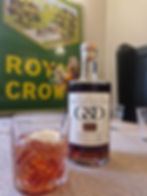Dubonnet vs Vermouth – The British Aperitif Explained
- Oliver Day
- 5 days ago
- 2 min read
If you’ve ever stood in front of a drinks cabinet and wondered what exactly Dubonnet is, you’re not alone. It looks a little like vermouth, sits in the same kind of bottle, and even shares a few ingredients. But it’s a very different creature — richer, smoother and, dare we say it, distinctly British.
In truth, Dubonnet and vermouth are cousins, not twins. Both began life in 19th-century Europe, made to make quinine and botanicals more palatable. Both were designed to be sipped before a meal. But where vermouth followed the Italian path of sharp, herbal intensity, Dubonnet took on a French warmth and spice that suits a slower, more civilised pour.
What makes Dubonnet different
Vermouth is a fortified wine flavoured with herbs and roots — often bitter, sometimes dry, and best known as a backbone for cocktails like the Martini or Negroni.
Dubonnet, on the other hand, is sweeter and more rounded. It’s built on red wine infused with herbs, spices and a touch of quinine. The result is a deep, garnet-coloured aperitif with notes of orange, spice and chocolate. Serve it on its own and it’s smooth and mellow. Add gin and it becomes something else entirely.
That combination is what caught the attention of a young Queen Elizabeth long before it became a royal ritual.
The British aperitif tradition
Britain never quite took to the French habit of drinking before lunch, yet a quiet group always kept the custom alive — the kind of people who knew that the right drink could set the tone for the day.
Dubonnet found its home in that world: the country house, the shoot lodge, the bar tray before Sunday lunch. It became the British aperitif precisely because it balanced ceremony with ease.

The proper way to enjoy it today
The easiest way to tell the difference between Dubonnet and vermouth is to taste them. Vermouth demands company; it wants to be mixed. Dubonnet doesn’t. All it needs is a good gin, ice and a slice of lemon.
At G&D, we’ve bottled that pairing properly — Dubonnet and Blackeye London Dry Gin, blended in England at 23 percent ABV. The flavour is unmistakable: rich, balanced, quietly confident.
A forgotten pleasure, revived
Dubonnet may have started in France, but it grew up in Britain. It’s part of our drinking language, the pause before conversation, the reminder that not every ritual needs changing.
So if you find yourself debating between Dubonnet and vermouth, remember this: one is continental, the other is quintessentially British.

Q1: What is the difference between Dubonnet and vermouth?
A: Dubonnet is a sweeter, richer aperitif made with red wine, herbs and quinine. Vermouth is more herbal and often drier, commonly used in cocktails.
Q2: Is Dubonnet a vermouth?
A: No. While both are fortified wines, Dubonnet is smoother and spiced, with a flavour closer to a sweet aperitif than a true vermouth.
Q3: How do you drink Dubonnet?
A: Traditionally, with gin, ice and a slice of lemon — a British ritual bottled today by G&D.


